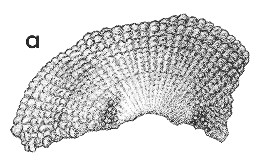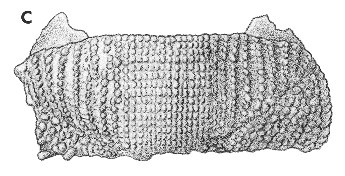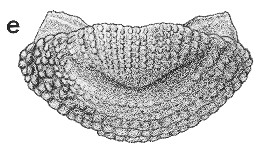
Revised descriptions of New Zealand Cenozoic Mollusca from Beu and Maxwell (1990)

 | Revised descriptions of New Zealand Cenozoic Mollusca from Beu and Maxwell (1990) | 
|
  (Pl. 43a): holotype, 110 m, off Otago Heads, eastern South Island, Recent (Australian Museum, Sydney, C95165; apparently the only 3 valves remaining) |
  (Pl. 43c): holotype, 110 m, off Otago Heads, eastern South Island, Recent (Australian Museum, Sydney, C95165; apparently the only 3 valves remaining) |
  (Pl. 43e): holotype, 110 m, off Otago Heads, eastern South Island, Recent (Australian Museum, Sydney, C95165; apparently the only 3 valves remaining) |
Beu & Maxwell (1990): Chapter 16; p. 330; pl. 43 a,c,e.
Synonymy: Lepidopleurus finlayi Ashby 1929b, p. 372; Terenochiton finlayi
Classification: Lepidopleuridae
Description: Very small (whole live animal to only 10 mm long, median valves to 3 mm wide), very thin and fragile, with evenly convex dorsum (i.e., no dorsal angle or jugum), without insertion plates but with small, triangular sutural laminae on fronts of valves 2-8. Sculpture coarse for genus, of widely spaced rows of relatively large granules on pleural areas and end valves, but random granules on lateral areas; unique peg-like spines (only partly preserved on figured specimen) project from posterior edge of valves 1-7.
Comparison: Leptochiton finlayi has been included as the only available figures of a large group of small, primitive chitons lacking insertion plates and having even granules all over the tegmentum. It is similar to the more common L. inquinatus (Altonian-Recent) but much smaller (L. inquinatus reaches 25 mm long) and more coarsely sculptured, with fewer than half as many rows of more widely spaced granules, and with posterior spines on valves 1-7 that are absent from L. inquinatus. L. inquinatus occurs commonly today all around New Zealand on hard substrates from the intertidal zone to about 60 m, whereas L. finlayi occurs moderately commonly on hard substrates all around New Zealand in about 50-300 m. Both are fairly common in washings from Castlecliff shellbeds, and L. finlayi occurs also in deep-water siltstone in southern Wairarapa (Mangapanian); L. inquinatus occurs also at Ohope Beach, Whakatane (Castlecliffian), Te Piki, near East cape (Haweran, oxygen isotope stage 7) and at many Miocene and Pliocene localities. The opportunity is taken to illustrate the three remaining valves of the Recent holotype of L. finlayi, and to point out Fleming's (1966b, p. 86) confusion of the type locality, stated wrongly as Castlecliff, Castlecliffian; Ashby (1929b, p. 373) recorded the holotype from 110 m off Otago Heads, eastern South Island. We agree with Kaas & Van Belle (1985a) that all named New Zealand Lepidopleuridae (except Parachiton textilis Powell, 1937, Recent, Three Kings Is.) belong in Leptochiton Gray, 1847 (= Terenochiton Iredale, 1914).
Distribution: Mangapanian-Recent; Recent, 110 m, off Otago Heads, eastern South Island (type).
Cite this publication as: "A.G. Beu and J.I. Raine (2009). Revised
descriptions of New Zealand Cenozoic Mollusca from Beu and Maxwell (1990). GNS
Science miscellaneous series no. 27."
© GNS Science, 2009
ISBN
978-0-478-19705-1
ISSN 1177-2441
(Included with a PDF facsimile file
copy of New Zealand Geological Survey Paleontological Bulletin 58 in CD version
from: Publications Officer, GNS Science, P.O. Box 30368 Lower Hutt, New
Zealand)